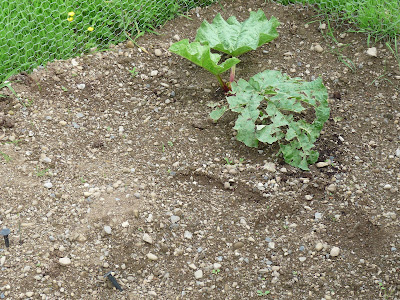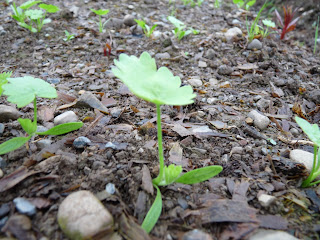Today was a landmark day for our little vegetable garden - as today we finished laying the last of the beds. The main body of work is now complete - we've transformed an unused piece of land to a lovely, productive allotment.
Just to illustrate the change in the aspect of the land:
From this...
...to this!
From this point on, the work that we do will be regular maintenance work that would happen on any allotment.
For the last two days, I've be forking through the rest of the soil breaking it up and removing the last of the rock and roots. Judging by my aches and pains, I'd imagine that I've shifted several tons of the offensive material at this stage.
I bit on the bullet and purchased a decent gardening fork - a choice I now wish I had made three months ago, as it made my work considerably easier, and I found that I was able to work more quickly (and with better results) using it.
I then laid out the last four beds - three of which have nothing planted in them yet. We're going to plant purple sprouting broccoli, over-winter carrots and most likely some leafy greens in these beds.
This is to be my last "All from nothing" post, as I feel that we've achieved what we set out to do, i.e setting up a vegetable garden.
Final thoughts:
I'd be lying if I said that this project wasn't a challenge. Working full time, and then attending to to allotment was sometimes difficult, and there were times when I did "hit a wall". However I genuinely feel that nothing worthwhile is ever easy, and I've never once felt that I'd wasted my time while on the allotment. As work progressed, it became easier to appreciate how great the final outcome would be.
I'd like to say a word of heartfelt thanks to the following people (in no particular order), who gave me a dig out along the way: Peter (our bromance continues!), Paddy M, my Dad (who has a half decent allotment too), Clare (obviously) and of course, the lady who gave us use of the land, to whom we are truly grateful (you're the best!).
Leeks.
We've planted our leeks in the first new bed I laid out. Our leeks have been grown from seed, and were at the point that they needed to be planted in the ground. I then laid out the last four beds - three of which have nothing planted in them yet. We're going to plant purple sprouting broccoli, over-winter carrots and most likely some leafy greens in these beds.
Chives and oregano.
The fourth bed, which lies at the apex of the row, is triangular in shape. In this, we've planted courgettes, chives and oregano. I used old tyres to "pot" the chives into. I had my reasons for doing this - we used to have herbs planted in terracotta pots in our back garden, and in the winter frosts they cracked apart. I'm hoping the same won't happen with rubber!
Courgettes.
Clare also sowed some extra peas, beetroot, spring onion and radishes, so we've have staggered growth with these.
This is to be my last "All from nothing" post, as I feel that we've achieved what we set out to do, i.e setting up a vegetable garden.
Final thoughts:
I'd be lying if I said that this project wasn't a challenge. Working full time, and then attending to to allotment was sometimes difficult, and there were times when I did "hit a wall". However I genuinely feel that nothing worthwhile is ever easy, and I've never once felt that I'd wasted my time while on the allotment. As work progressed, it became easier to appreciate how great the final outcome would be.
I'd like to say a word of heartfelt thanks to the following people (in no particular order), who gave me a dig out along the way: Peter (our bromance continues!), Paddy M, my Dad (who has a half decent allotment too), Clare (obviously) and of course, the lady who gave us use of the land, to whom we are truly grateful (you're the best!).
It feels appropriate, at this point, to show photos of whatever beds I haven't covered yet in this post. So here they are, taken clockwise from the left of the gate as you enter the allotment.
Carrot bed.
Lettuce and potato beds.
Swede, corn and beetroot bed.
A closer look at our beetroot...
... and our corn.
Our pea plants are starting to produce fruit.
Asparagus and rhubarb beds (asparagus is to small to see).
I've gone over the next couple of bed already in this post, so I'm skipping them. Next up:
Brassicas.
And finally, the potato frame - needs another level at this stage!
And that concludes the the tour.
As always, I'd love to hear your thoughts or comments on what we've done so far.

















































